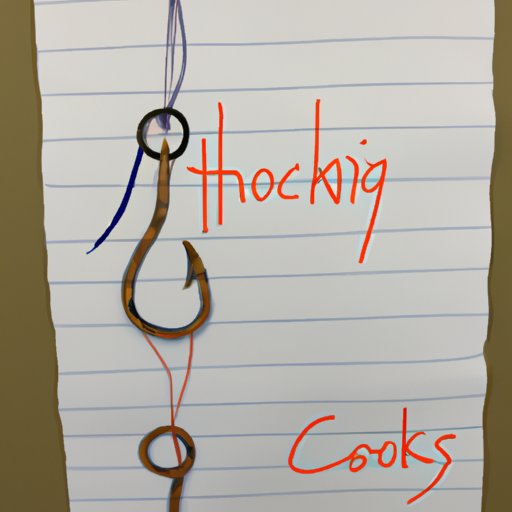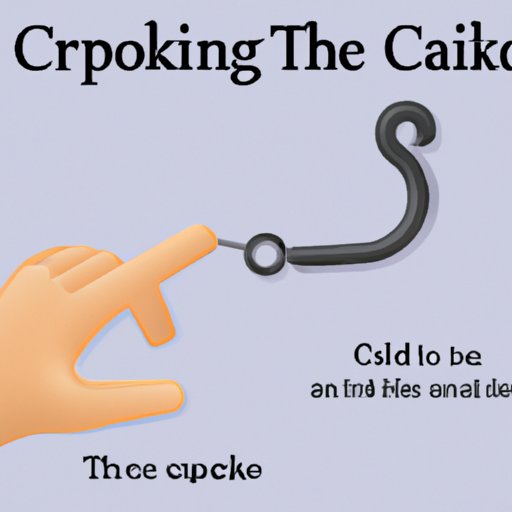Introduction
A hook is a statement or element in a piece of writing that grabs the reader’s attention. It can be a phrase, sentence, or even an image. Hooks are essential in all types of writing, from stories, to essays, to articles, or books. They are the first thing readers see and can make or break the experience. By using an effective hook, writers can entice their readers and keep them engaged.

Exploring the Power of Hooks in Writing
Hooks have the power to draw readers into a story and keep them wanting more. There are many different types of hooks, each suited to a different purpose. For example, a rhetorical question can be used to spark interest and encourage readers to think about the answer. A quote or statistic can be used to emphasize a point or add credibility to an argument. And a shocking statement can be used to surprise readers and capture their attention.
Types of Hooks
There are several different types of hooks that can be used in writing. Some common types include:
- Rhetorical questions
- Quotes or statistics
- Shocking statements
- Imagery
- Metaphors or similes
- Dialogue
Examples of Hooks
Here are some examples of effective hooks:
- “What if I told you there was a way to turn back time?”
- “The average person spends 8 hours a day on their phone.”
- “She opened the door, and her life changed forever.”
- “The sun peeked through the clouds like a mischievous child.”
- “He had a plan so bold it would make history.”
- “I’ve made a decision,” she said. “And there’s no going back.”

How to Craft a Captivating Hook for Your Writing
Crafting a captivating hook for your writing is not always easy. However, there are some tips and tricks that can help make the process easier. The first step is to understand your audience and what they are looking for. This will help you determine what type of hook to use and how to best present it. Once you know who your audience is, you can brainstorm ideas for your hook and start drafting.
Crafting an Eye-catching Hook: Strategies and Examples
Using metaphors and similes is one way to craft an eye-catching hook. Metaphors and similes can help paint a vivid picture in the reader’s mind and draw them in. When using these figures of speech, it’s important to avoid clichés. Clichés can be off-putting to readers and often fail to grab their attention. Here are some examples of eye-catching hooks using metaphors and similes:
- “The waves crashed against the shore like thunder.”
- “Her heart raced like a freight train.”
- “The sky was alive with stars, twinkling like diamonds.”
- “He spoke with the confidence of a lion.”
- “The room was as silent as a graveyard.”
Using Hooks to Grab Your Readers’ Attention
Surprise and shock are two powerful tools when it comes to grabbing your readers’ attention. By introducing a twist or unexpected event, you can leave your readers wanting to know more. Creating tension is another great way to draw in your readers. By leaving unanswered questions or creating suspense, you can keep your readers hooked until the end. Dialogue is also a great way to grab your readers’ attention. By including dialogue in your hook, you can give your readers a glimpse into the characters and create an engaging opening.
Creating a Hook for Your Story: Tips and Techniques
When creating a hook for a story, it’s important to establish setting and tone. Establishing setting and tone helps readers get a better understanding of the world and characters before diving into the story. Introducing characters is also an effective way to create a hook. By introducing characters early on, the reader can start forming connections and become more invested in the story. Finally, it’s important to establish the conflict. Introducing the conflict early on can help readers understand the stakes and keep them engaged.
Writing Compelling Hooks: A Step-by-Step Guide
Writing compelling hooks doesn’t have to be difficult. The first step is to identify your narrative voice. Do you want to write in first person or third person? Do you want to use a formal or informal tone? Once you’ve identified your narrative voice, you can choose your hook. Think about what type of hook will work best for your story and what message you want to convey. Once you’ve chosen your hook, you can start writing and revising until you are satisfied with the result.
Creative Hooks: Unlocking Your Story’s Potential
Creative hooks can help you unlock the potential of your story. Using imagery is a great way to create a captivating hook. Imagery can be used to evoke emotion and set the tone for the story. Making connections is another great way to create a hook. By connecting two seemingly unrelated ideas, you can create intrigue and draw readers in. Finally, finding inspiration is key. Look for inspiration in books, movies, art, or even real-life events. This can help you come up with unique and creative hooks for your story.
Conclusion
Hooks are an essential part of any piece of writing. They can help draw readers in and keep them engaged. There are many different types of hooks, each suited to a different purpose. By understanding your audience and brainstorming ideas, you can craft a captivating hook that will grab your readers’ attention. With the right hook, you can unlock the potential of your story and create an unforgettable experience for your readers.
(Note: Is this article not meeting your expectations? Do you have knowledge or insights to share? Unlock new opportunities and expand your reach by joining our authors team. Click Registration to join us and share your expertise with our readers.)
